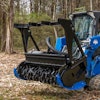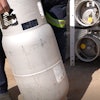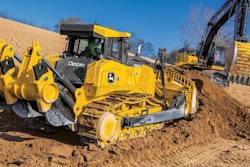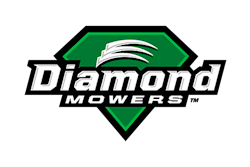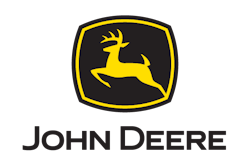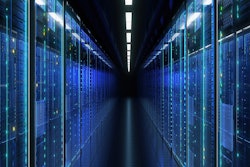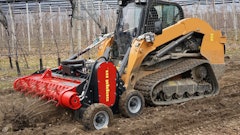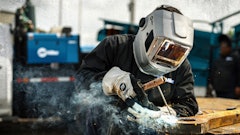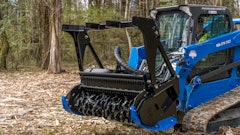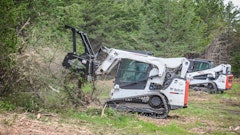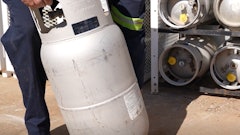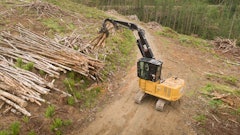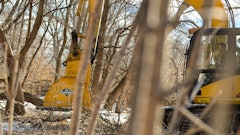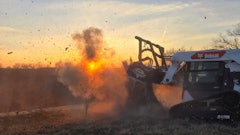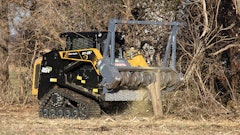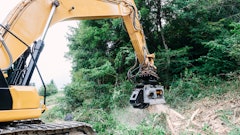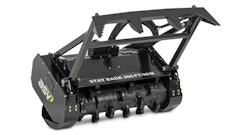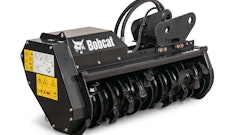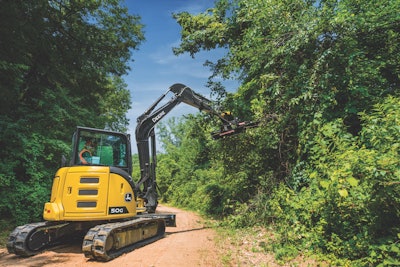
As the construction industry continues to flourish, site preparation and land clearing work are steadily becoming more popular, as well. In response, numerous manufacturers are offering a wider range of equipment that enables professionals and contractors to clear land and brush as they prepare for new construction opportunities.
For example, Caterpillar has a brush cutter, the Cat BR320, that can remove thick brush and saplings, allowing operators improved access to their properties, which is the “first step in a land clearing job,” according to Brock Bahr, senior sales support specialist, Caterpillar. To create a clear path and have as clean of a finish as possible, Bahr advises operators to pair the BR320, which can cut a tree of up to 3 inches in diameter, with a D3 Series skid steer or compact track loader (CTL).
Upon clearing smaller, thick brush, operators can then focus on more significant obstacles. Bahr believes they should utilize an industrial brush cutter or mulchers, whichever option is the most ideal for them, according to their particular property’s terrain and accessibility.
“The Cat BRX318 industrial brush cutter can do everything the BR series can and more, as it was designed for land management, small trees and dense vegetation,” Bahr stressed. “With its four blades, reinforced push bar and open-face design, the BRX can get close to large debris, such as trees that are up to 8 inches in diameter, as it cuts them close to the ground.”
He added, “It pairs well with skid steers, CTLs and compact wheel loaders, too. Although the BR series leaves a much cleaner finish, if operators want to remove everything and the final finish isn’t an issue, they should consider using the Cat BRX318.”
To remove large trees, operators can also use a mulcher. Caterpillar currently provides nine different models, along with two different drum styles. The manufacturer’s most common drum style is its standard or open drum mulcher, offered with either carbide teeth (such as the HM316 and the HM418) or reversible chisel teeth (like the HM112 and the HM215).
According to Bahr, the mulchers’ standard or open drums don’t limit tooth engagement, resulting in a significant bite and, in turn, higher productivity. If operators are working on sites that have rough and rocky terrain, Bahr thinks carbide teeth are their most ideal option. After all, they’re highly durable and more forgiving than chisel teeth. And they require less maintenance than chisel teeth, as they’re less prone to damage.
In addition, the manufacturer provides depth control or bite limiter drums on its HM316, HM416 and HM418 offerings. Each of these drums have chisel teeth and depth control rings that decrease bite size and offer operators a helical tooth pattern. Consequently, the HM316, HM416 and HM418 can cut faster, burn less fuel and provide operators a cleaner finished product, when compared to other mulchers on the market, Bahr said.
“Each Cat mulcher comes standard with a heavy-duty, adjustable push bar, as well, which directs 8-inch trees away from operators as they cut,” Bahr said. “Furthermore, every Cat mulcher has adjustable, replaceable skid shoes, a two-speed hydraulic motor and a color-coded pressure gauge, which offers operators feedback, leading to higher productivity.”
Prior to purchasing a Caterpillar industrial brush cutter or mulcher, operators should keep in mind how much space they have to operate the machines, as they require some space for maneuverability, to be as close to the tree bases as possible. If operators don’t have enough space, they can also consider buying a mini excavator, which can be parked in one location, as it’s able to reach out to cut several trees and brush without ever having to be moved.
Once operators have removed trees, whether they choose to use an industrial brush cutter, a mulcher or a mini excavator, they must eliminate stumps, too. To do so, operators can attach Caterpillar’s 46-inch stump bucket, which can be used for small stumps and roots, in particular. Offering a long, narrow design with serrated edges, the stump bucket enables operators to dig closely around, and underneath, stumps’ root balls.
Operators can consider using Caterpillar’s SG36 stump grinder, as well. Featuring a 22-inch cutting wheel with 32 carbide teeth, the SG36 is known for its ability to rapidly remove stumps.
“To ensure they quickly and efficiently remove whichever stumps they need to, operators can extend the SG36’s head up to 11 inches and swing it 60 inches to the right and left, if necessary,” Bahr added. “Not to mention, while grinding stumps (up to 20.5 inches below the ground), operators will never have to leave the comfort of their cabs, either.”
Enhancing Productivity and Aesthetics
In the past, site preparation was completed by pushing vegetation over with dozers and excavators. Unfortunately, this process led to a considerable mess of brush and branches, which they would generally need to burn. Brush cutters and mulchers allow for a cleaner option that allows contractors to remove vegetation in a mechanized fashion instead.
In addition to offering a cleaner finish, these mechanized options are evolving, said Matt Nelson, director of development at Diamond Mowers. For instance, mulching attachments are becoming more efficient, with regard to the ways in which they cut and mulch, as they’re leveraging enhancements in components such as hydraulic motors and cutting tooth technology.
Moreover, mulcher attachments, which were previously suitable for large-frame and high-flow skid steers and CTLs, have become smaller, lighter and, consequently, more efficient, as they can be utilized on smaller, mid-frame machines. Therefore, contractors no longer have to purchase machines that are only dedicated to land clearing. Rather, they can use the loader they already have and choose whichever attachment fits, resulting in cost savings.
In preparation for the future of mulching, Diamond Movers recently announced its Belt Drive Disc Mulcher, which features a patented driveline that leverages a two-speed hydraulic motor that runs through a gear-reduction belt system. Due to its design, it increases operators’ production by 20% to 40%, in comparison to traditional disc mulcher designs. And, of equal importance, it also diminishes hydraulic oil temperatures.
“We believe the mulcher will positively impact the contractor market, as its ability to enhance productivity will ensure it’s a clear choice for those who are paid according to output,” Nelson said.
In the meantime, Diamond Mowers has released the Drum Mulcher OD (open drum) Pro X as well, which provides a hybrid design that integrates the features of depth control and open drum mulchers into one attachment. Created to enable heavy ground engagement, the product has an infeed system that leads to a smaller, more uniform and aesthetically-pleasing end product once operators have finished their first pass.
“It has not only allowed contractors and landowners to realize an improved finished product, but it has also reduced their operating costs and boosted their profits,” Nelson emphasized.
With regard to brush cutters, Diamond Mowers presently has two options, the Brush Cutter Pro and the Brush Cutter Pro X. Each of these attachments are compatible with skid steer carriers or CTLs, as they feature hydraulic motors that are properly sized for enhanced blade performance and safe handling at every flow level.
Offering high durability and multi-faceted cutting capabilities, the Brush Cutter Pro can be used for a wide array of applications and carriers. After all, it has two steel blades that can maintain a 72-inch cutting width, while cutting through branches, brush, grass and small trees that are up to 5 inches wide. Featuring a lower push bar, the Brush Cutter Pro can reach underneath fences, too.
Meanwhile, the highly powerful and versatile Brush Cutter Pro X provides three cutting widths: 60, 72 and 84 inches. Utilizing three steel blades, it also has a Tr-Hex cutting disc that can slice through various materials, including those that have diameters of up to 10 inches.
Once operators have used the Belt Drive Disc Mulcher, the Drum Mulcher OD (open drum) Pro X, the Brush Cutter Pro or the Brush Cutter Pro X, Nelson advises them to utilize one of Diamond Mowers’ two stump grinders, the Reflex Stump Grinder or the Miller Stump Grinder. Particularly ideal for land clearing and rural grinding applications, the Reflex Stump Grinder uses a skid steer’s lift arm to position its wheel in a stump prior to driving it through the wood with its wheels or tracks.
“Easy to operate, the Reflex Stump Grinder is equipped with a patented cushioning device that protects the wheel from too much pressure, alleviating overload by flexing and keeping the wheel out of harm’s way,” Nelson said. “Grinding wheels are available in 24-inch or 26-inch cutting widths and are paired with an appropriately sized motor to match the machine’s hydraulic flow.”
Meanwhile, the Miller Stump Grinder can cut stumps up to 36 inches in diameter, as operators never have to move the carrier. Utilizing a 26-inch, six-way grinding wheel that features swing, lift and telescoping functions, the stump grinder enables operators to process a stump while the loader is parked in one position.
“Therefore, the risk of soil and turf damage declines,” Nelson added. “With this in mind, it is especially ideal for settings in which aesthetics are important.”
Clean, Suitable Jobsites
Although construction projects are diverse with regard to their various types and locations, contractors all strive for one common goal — a clean, suitable jobsite. To achieve this objective in the most effective manner possible, they should utilize mulching equipment, particularly drum mulcher attachments, according to Ryan Bricker, product manager at Fecon. Attachments, after all, are not only efficient, but convenient, too, as they can be effortlessly paired with equipment found on most jobsites.
To provide operators efficient and convenient mulching equipment, Fecon has several attachments they can choose from, including models that have been optimized for standard-flow and high-flow skid steers and excavators. One attachment that has recently been added to the manufacturer’s mulcher attachment lineup is the BULL HOG RK6015 skid steer drum mulcher. A standard flow mulcher attachment developed especially for landscape construction and lighter vegetation management, it can mulch brush and trees that are up to 5 inches in diameter.
“It’s ideal for right-of-way maintenance for road construction, as well as clearing of smaller lots for building projects,” Bricker noted. “In addition, it’s optimized for 50 to 75 horsepower skid steers, which can be found on virtually any construction jobsite.”
Furthermore, contractors can utilize the manufacturer’s FMX28 mulcher, which has been created for 3.5- to 8-ton standard-flow excavator models, as it can clear trees and brush alongside creeks, ravines, riverbanks, roads and other areas that are difficult to reach. Also a draw for rental centers, in particular, the mulcher offers contractors an attachment option that’s effortless to rent, use for a project and return once the project has been completed.
“Because of excavators’ unique operations, the mulcher opens the door to the usage of compact excavators in mulching applications, specifically for selective or precision mulching,” Bricker explained. “It’s especially suitable for clearing small pads for tower construction or removing invasive species.”
Finally, contractors can use the BLACKHAWK BK6218, a mulcher that’s been designed to quickly process the fibrous, stringy vegetation that’s typically found in the Southeast.
“Utilizing a DCR rotor, a shear bar, a wear liner and a body geometry that enables it to tackle trees that have fallen or are standing, the mulcher can clear any jobsite,” Bricker added. “And, due to its rear throat, it can process debris during back dragging, without ever leaving any unprocessed materials behind.”
Various Options for Land Clearance
Without question, contractors have a wide array of options to clear land at jobsites. Sometimes the job calls for equipment with specific functions. Other times, equipment is chosen based on the types of brush and land they need to clear. With this in mind, John Deere Construction & Forestry has a variety of equipment for operators to choose from.
“We provide drum-style mulchers that can process material into smaller pieces, along with disc-style cutters that cut, knock down and process the larger pieces,” said Doug Laufenberg, solutions marketing manager, attachments at Deere. “If timeliness is critical, disc-style cutters may be the more suitable option, as they’ll likely cover more ground faster, since they aren’t processing material into smaller pieces.”
Deere also offers grapples and root rakes in which operators can knock down the growth and then gather material with a grapple or a rake to dispose of it another way, he added.
Recently, Deere added drum and disc mulchers to its compact excavator lineup. Furthermore, the manufacturer has introduced a depth control rotor on its skid/CTL mulcher. As a result of the rotor, operators can minimize “the bite that the drum (of each drum mulcher) can take on trees,” according to Laufenberg. It also allows operators to work with thinner, twiggy wood more efficiently, whenever they need to cut and process brush and trees.
To ensure land and brush clearing is more effortless for operators, the manufacturer offers specialized attachments like the ME36 and ME50 mulchers, which are equipped with knife-style cutting teeth on a split ring motor.
“The mulchers’ spiral, double helix tool patterns, along with their tool shapes, enable operators to quickly and efficiently cut mulch that’s up to 5 inches in diameter,” Laufenberg said.
Deere provides brush cutters like the RE40 and the RE50 that offer more versatility for excavators. Especially ideal for embankment and ditch management, over-fence brush management and rail right-of-way maintenance, the brush cutters can be used for other areas that are difficult to reach, as well.
“Each of these attachment offerings allow operators to tackle land clearing and brush cutting tasks with the equipment they likely already own,” Laufenberg stressed. “However, since they’re made specifically for brush cutting and land clearing, operators can achieve these tasks more efficiently than they previously did.”
Evolution is the Name of the Game
As evidenced by the wide assortment of product offerings on the market, from brush cutters, to mulchers and stump grinders, land and brush clearance is a complicated undertaking. Clearing jobsites is only becoming more and more complicated as the construction industry continues to evolve.
The bottom line? Operators’ equipment use must evolve, as well, to ensure their land and brush clearance processes are as effective and straightforward as possible.
“As roads and utility infrastructures expand and alternative energy sources grow, the need for brush and land clearing will only continue to grow, too,” Fecon’s Bricker said. “Evolution will be the name of the game, as manufacturers continue to respond to this growth through continuous changes. Due to these evolutions in products and the demand for them, the future is certainly bright for brush and land clearing equipment manufacturers — and each of the professionals and contractors that utilize their offerings.”


